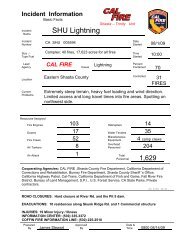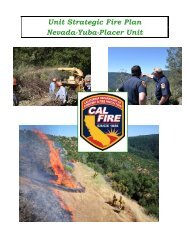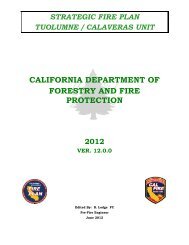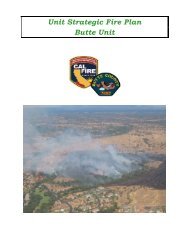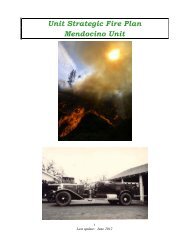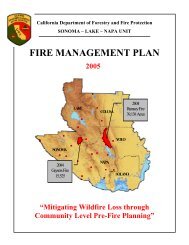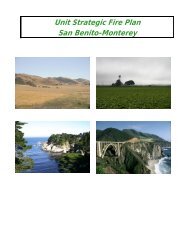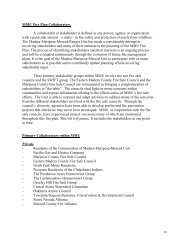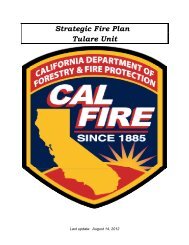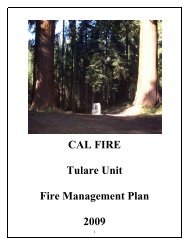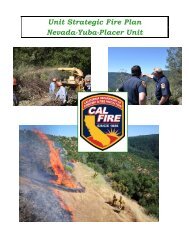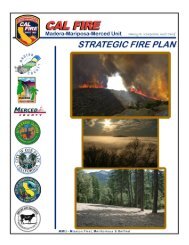Lassen – Modoc Unit - Board of Forestry and Fire Protection - State ...
Lassen – Modoc Unit - Board of Forestry and Fire Protection - State ...
Lassen – Modoc Unit - Board of Forestry and Fire Protection - State ...
Create successful ePaper yourself
Turn your PDF publications into a flip-book with our unique Google optimized e-Paper software.
FIRE MANAGEMENT PLAN 2008<br />
<strong>Lassen</strong>-<strong>Modoc</strong> <strong>Unit</strong><br />
arrangement <strong>and</strong> number <strong>of</strong> structures per lot. This density affects the<br />
overall exposure, spread <strong>and</strong> intensity <strong>of</strong> wildfires.<br />
Additional Considerations<br />
Endangered Species<br />
Endangered Plants<br />
Environmental Impact<br />
Visual Impact<br />
2) Slope<br />
Slope is defined as the upward or downward incline or slant <strong>of</strong> the<br />
terrain. All other variables being equal, a fire traveling up a slope will<br />
move faster <strong>and</strong> have longer flames than a fire traveling on flat<br />
terrain—a fire on a 30 percent slope can produce flames twice the<br />
length <strong>and</strong> travel as much as one <strong>and</strong> one half times as fast, as a fire<br />
on flat ground.<br />
Additional Considerations<br />
Aspect<br />
Dangerous Terrain<br />
Position by Slope<br />
Percent Slope<br />
3) Weather<br />
All aspects <strong>of</strong> weather can affect the fire assessment. Temperature,<br />
humidity <strong>and</strong> winds will affect the probability <strong>of</strong> ignition <strong>and</strong> the ability<br />
to control <strong>and</strong> extinguish the fire. Weather patterns such as long <strong>and</strong><br />
short-term droughts need to be considered.<br />
Additional Considerations<br />
Drought Factor/Index<br />
Historic Climatological Data<br />
National <strong>Fire</strong> Danger Rating System<br />
4) <strong>Fire</strong> Occurrence<br />
The history <strong>of</strong> wildfires can provide a valuable dimension for the<br />
assessment. There will be an increase in the probability <strong>of</strong> a fire<br />
occurring in environments where they have occurred in the past. The<br />
severity <strong>and</strong> frequency <strong>of</strong> fires enable authorities to determine the<br />
resources required.<br />
Step 3: Rank the hazard components<br />
Develop or use an existing system to define the significance <strong>of</strong> each<br />
hazard component. The system, though subjective in nature, should be<br />
specific <strong>and</strong> consistent.<br />
For example NFPA 299 St<strong>and</strong>ard for the <strong>Protection</strong> <strong>of</strong> Life <strong>and</strong> Property<br />
(the system used in this web site), 1997 Edition, uses a numerical rating<br />
system to define the relative contributions <strong>of</strong> several components. To<br />
129



